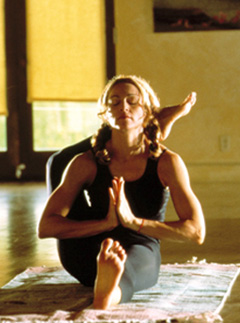Yoga exercises
like Sun Salutation, Cobra pose, Locust pose, Bow pose, Standing Forward Bend
and Kapalabhati few to name are strictly not recommended if somebody is
diagnosed
with hernia.The practitioners need to understand that their ignorance and lack of yoga
knowledge may lead them straight into an operation room”.
 |
| Yoga, Hernia and Madonna |
with hernia.The practitioners need to understand that their ignorance and lack of yoga
knowledge may lead them straight into an operation room”.
Energizing Yoga,
the oldest system of personal development needs no introduction nowadays and is
becoming popular all over the world because of its tremendous physical and
medical benefits. People are practicing yoga exercises in millions all over the
world, thanks to the media which is highlighting the benefits of yoga for
general public.
However, like every other science, yoga is also a precise science. The question is: ‘Are all yoga exercises safe to be practiced by all people with various health conditions?’
“This is the question which requires deeper digging into the subject of yoga itself, otherwise the consequences of doing yoga practice could be more dangerous than beneficial” said Subodh Gupta, the Yoga expert from India.
”While some of the yoga exercises can be taught easily without much complication and have various benefits, others can be very dangerous for people who are having problem of Hernia. For example, the yoga exercises like Sun Salutation, Cobra pose, Locust pose, Bow pose, Standing Forward Bend and Kapalabhati few to name are strictly not recommended if somebody is diagnosed with hernia as these exercises may make the hernia problem worse” said Subodh Gupta, the Yoga expert based in London.
Considering the fact that over half a million hernia operations were performed in the United States last year and more than 2 percent of British people are affected by hernia, the question to ask is if all yoga practitioners are aware of their health condition and precautions before beginning the Yoga exercise. Madonna, the famous singer who practices Ashtanga yoga regularly recently had an operation for hernia (Ashtanga yoga exercise series is a system developed by Mysore based famous Indian Yoga guru Shri K Pattabhi Jois). In fact, the famous Ashtanga yoga series which involves jumping can be very dangerous for people who are having problem of Hernia” according to Subodh Gupta. Hernia develops when the outer layers of the abdominal wall weakens, bulge or actually rip. Among many reasons for hernia the most common is straining due to: jumping, defecation, coughing, lifting heavy objects, etc.
‘Are precautions for various yoga exercises safely delivered by yoga Gurus?’ ‘Are yoga practitioners listening precautions before starting their yoga practice?’
“Well, this is a serious point to consider by all who are teaching yoga and also for people who are practicing yoga. The practitioners need to understand that their ignorance and lack of yoga knowledge may lead them straight into an operation room” said Subodh Gupta.
A noble effort has been done by some of the renowned yoga gurus from India and the teachers from the West to spread the awareness of yoga but unless Yoga exercises are done with precautions, more and more people will get injured without realizing.
Issued in public interest by Subodh Gupta, Yoga Expert from India, for all those who are learning yoga without taking precautions.
However, like every other science, yoga is also a precise science. The question is: ‘Are all yoga exercises safe to be practiced by all people with various health conditions?’
“This is the question which requires deeper digging into the subject of yoga itself, otherwise the consequences of doing yoga practice could be more dangerous than beneficial” said Subodh Gupta, the Yoga expert from India.
”While some of the yoga exercises can be taught easily without much complication and have various benefits, others can be very dangerous for people who are having problem of Hernia. For example, the yoga exercises like Sun Salutation, Cobra pose, Locust pose, Bow pose, Standing Forward Bend and Kapalabhati few to name are strictly not recommended if somebody is diagnosed with hernia as these exercises may make the hernia problem worse” said Subodh Gupta, the Yoga expert based in London.
Considering the fact that over half a million hernia operations were performed in the United States last year and more than 2 percent of British people are affected by hernia, the question to ask is if all yoga practitioners are aware of their health condition and precautions before beginning the Yoga exercise. Madonna, the famous singer who practices Ashtanga yoga regularly recently had an operation for hernia (Ashtanga yoga exercise series is a system developed by Mysore based famous Indian Yoga guru Shri K Pattabhi Jois). In fact, the famous Ashtanga yoga series which involves jumping can be very dangerous for people who are having problem of Hernia” according to Subodh Gupta. Hernia develops when the outer layers of the abdominal wall weakens, bulge or actually rip. Among many reasons for hernia the most common is straining due to: jumping, defecation, coughing, lifting heavy objects, etc.
‘Are precautions for various yoga exercises safely delivered by yoga Gurus?’ ‘Are yoga practitioners listening precautions before starting their yoga practice?’
“Well, this is a serious point to consider by all who are teaching yoga and also for people who are practicing yoga. The practitioners need to understand that their ignorance and lack of yoga knowledge may lead them straight into an operation room” said Subodh Gupta.
A noble effort has been done by some of the renowned yoga gurus from India and the teachers from the West to spread the awareness of yoga but unless Yoga exercises are done with precautions, more and more people will get injured without realizing.
Issued in public interest by Subodh Gupta, Yoga Expert from India, for all those who are learning yoga without taking precautions.
Keywords:
Yoga, Ashtanga Yoga, hernia, Subodh Gupta




